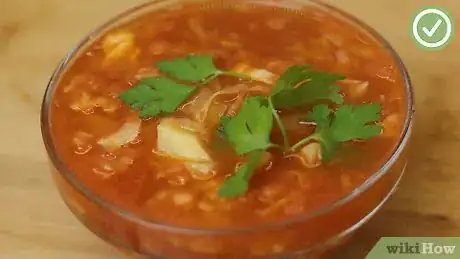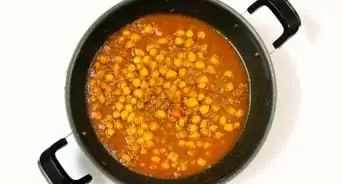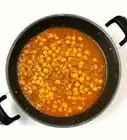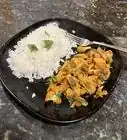This article was co-authored by wikiHow Staff. Our trained team of editors and researchers validate articles for accuracy and comprehensiveness. wikiHow's Content Management Team carefully monitors the work from our editorial staff to ensure that each article is backed by trusted research and meets our high quality standards.
The wikiHow Video Team also followed the article's instructions and verified that they work.
This article has been viewed 32,152 times.
Learn more...
Vegetable curry is not only a delicious Indian-style dish; it also happens to be pretty good for you! Even if you've never cooked Indian food before, vegetable curry is a pretty simple meal to make. You simply need to saute your ingredients together and let them simmer for about 20 minutes. Then, garnish and enjoy!
Ingredients
- 2 tablespoons (30 mL) of olive oil
- 1 medium onion, finely chopped
- 2 cloves of crushed garlic
- 1 tablespoon (7 grams) of freshly grated ginger
- 2 teaspoons (5 grams) of garam masala
- 1 teaspoon (2.5 grams) of coriander
- ½ teaspoon (1.25 grams) of cumin
- ½ teaspoon (1.25 grams) of turmeric
- ½ teaspoon (1.25 grams) of black pepper
- 1 minced serrano pepper (optional)
- 2 cups (470 mL) of vegetable broth
- 2 tablespoons (30 mL) of tomato paste
- 1 large potato, peeled and cubed
- 1 head of cauliflower, broken into small pieces
- 1 can of frozen peas
- 2 carrots, chopped
- 2 tablespoons (15 grams) of fresh cilantro
Yields: 4-6 servings
Steps
Sauteing the Onions and Spices
-
1Pour the olive oil in a saucepan and place it over medium heat. For best results, use 2 tablespoons (30 mL) of olive oil poured into the center of the saucepan. Olive oil is typically used for vegetable curry, but you can also use vegetable oil if you'd prefer. [1]
- The medium heat setting is the middle number on the dial that controls the temperature on your stovetop.
-
2Add the onions and garlic to the saucepan and saute them for 5 minutes. Be slow and careful when you add the onions and garlic, as the oil may splash out of the pan if you drop them in too quickly. You'll want to saute until the onions turn golden, which should take around 5 minutes, although this may only take 2-3 minutes on some stoves.[2]
- Make sure you continuously stir the ingredients together as you saute to prevent them sticking to the pan and to make sure they're evenly cooked through.
Advertisement -
3Stir your spices into the mix and continue cooking for 2-3 minutes. Add 1 tablespoon (7 grams) of freshly grated ginger, 2 teaspoons (5 grams) of garam masala, 1 teaspoon (2.5 grams) of coriander, ½ teaspoon (1.25 grams) of cumin, ½ teaspoon (1.25 grams) of turmeric, and ½ teaspoon (1.25 grams) of black pepper to the onions and garlic. Stir the spices throughout the pan as you continue cooking in order to evenly distribute them.[3]
- If you want your curry to be a bit spicier, you can also add 1 minced serrano pepper at this point.
Simmering the Vegetables
-
1Add the vegetable broth, tomato paste, and vegetables to the pan. Carefully pour 2 cups (470 mL) of broth into the pan first, followed by 2 tablespoons (30 mL) of tomato paste. Then, add the potato, cauliflower, carrots, and peas, stirring the mixture to evenly coat the vegetables with the sauteed spices.[4]
- Be sure to slowly add the vegetables to the pan to avoid splashing the broth everywhere.
- Other vegetables you may want to add to your curry include eggplant, green beans, and spinach.
-
2Continue stirring the mixture and bring it to a boil. It should only take a few minutes for the contents of the pan to start lightly boiling. If the mixture becomes too thick at this point, add a little bit of water to it.[5]
-
3Reduce the heat to medium-low, cover the pan, and let the mix simmer. Simmer the curry for 20 minutes or until the potatoes are tender. The potatoes should be neither too mushy nor too hard once they're tender, but should give easily when you poke them with a fork.[6]
- The medium-low setting is the number halfway between the medium and low setting on your stovetop dial.
-
4Transfer the curry to a serving dish and garnish it with fresh cilantro. Sprinkle 2 tablespoons (15 grams) of cilantro over your curry to garnish it, although this isn't strictly necessary (especially if you don't like cilantro). Serve your finished curry over rice or flatbread.[7]
- Other garnishes you might use for your curry include chopped parsley leaves and flaked almonds.
Warnings
- Be very careful when working with hot oil, since it can cause painful scalds if it gets on you.⧼thumbs_response⧽
- Make sure to test if the vegetables have been thoroughly cooked before serving the dish. You can test them by inserting a knife into one of the vegetables to see if it easily cuts open. If it's tough to cut, let the curry simmer a little more until the vegetables are fully cooked.⧼thumbs_response⧽
References
- ↑ https://www.allrecipes.com/recipe/81051/vegetable-curry/
- ↑ https://www.allrecipes.com/recipe/13982/quick-and-easy-vegetable-curry/
- ↑ https://www.connoisseurusveg.com/easy-mixed-vegetable-curry/
- ↑ https://www.allrecipes.com/recipe/81051/vegetable-curry/
- ↑ https://www.connoisseurusveg.com/easy-mixed-vegetable-curry/
- ↑ https://www.allrecipes.com/recipe/81051/vegetable-curry/
- ↑ http://www.layersofhappiness.com/the-best-vegetable-curry-ever/
About This Article
To make vegetable curry, start by sauteeing chopped onions and crushed garlic over medium heat for 5 minutes. Then, add grated ginger, garam masala, coriander, cumin, turmeric, and black pepper, and cook everything for 2-3 more minutes. Next, add vegetable broth, tomato paste, and vegetables to the pan, bring everything to a boil, and then reduce the heat to medium-low. Finally, cover the curry and let it simmer for 20 minutes before serving it. To learn how to serve your vegetable curry, scroll down!















































